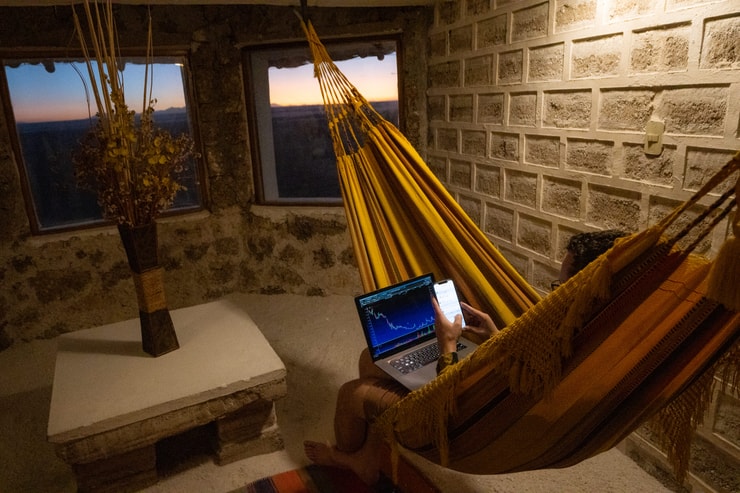Ever notice how two people can hit the gym, do the same exercises, but end up with completely different results?
The secret’s in their diet – the nutrition that turns routine into transformation.
The same applies to trading.
We’re all eyeing similar tickers, but what separates the pros from the novices is risk management—the nutrition of trading.
Today, I’ll share four game-changing risk-proofing strategies: targeting important price levels, nailing position sizing, balancing risk vs reward, and mastering the art of cutting losses quickly.
This is your personalized trading nutrition plan, designed to beef up your portfolio. Get ready to trade like a pro.
Table of Contents
#1 Price Levels

2025 Millionaire Media, LLCThink of price levels as your dietary guidelines—knowing what’s good and bad for you.
You wouldn’t load up on junk food if you’re aiming for a six-pack, right?
Similarly, knowing when to enter and exit a trade is crucial. Whether it’s support, resistance, or Fibonacci levels, always have a plan.
Newer traders see my ~75% win rate and automatically assume I have some secret formula to find the perfect spot to buy morning panic dips.
The truth is I use the same techniques most of you know.
Want a quick way to find a price level?
Look for areas where the market found support or resistance in the past.
Take a look at the chart for Verb Technology Co. (NASDAQ: VERB):
All I did here was extend lines where the stock halted up or down.
Each line that it touched acted as support or resistance on the first hit all three times.
Is that guaranteed?
Hardly.
The point is you don’t need some magic equation. Just identify prices that should be important as your first step.
Then you look for a setup and price action at or near that level to initiate the trade.
#2 Position Sizing

2025 Millionaire Media, LLCEver overeat and regret it later?
That’s what overleveraging feels like in trading.
Position sizing is like portion control; it’s all about how much of a particular stock you’re willing to “consume” relative to your overall portfolio.
Too much of even a good thing can lead to indigestion—or, in trading terms, massive losses.
When I’m dealing with penny stocks, volatility is a given.
I don’t play these stocks expecting a 1%-2% move.
I’m looking for 5%-10% on a ticker that’s up or down tens if not hundreds of percentage points in a day.
The greater the volatility, the smaller my position size. It’s that simple.
Making 5% on one stock with your normal position size gets you the same profit as 10% gains with half your position size.
So, how do you determine your position size?
More Breaking News
- URG’s Steady Climb: Optimism or Omen?
- GRAB Stock Surge Amid Key Market Events
- Lumen Technologies’ Strategic Moves: Impact on Stock Prices?
That’s where the last two strategies come into play.
#3 Risk vs Reward

2025 Millionaire Media, LLCI love to eat.
You’ll often find me on a run just so I can sit down for a large dinner without feeling immense guilt.
But you know what I wouldn’t do?
Run a marathon to eat a single slice of pizza. It’s just not worth it.
Trading is all about weighing the risk against the reward.
For example, if a trade offers a 2% gain but comes with a 10% downside, it’s like sweating out an hour for a tiny treat. Not worth it!
My goal is to get multiples of what I risk out of each trade.
That’s why if you look at any given trade I’ve taken and compare it to my average win or loss, they aren’t that far apart.
I consistently seek to keep my losses to a fraction of my wins.
This leads me to the 4th and most important strategy of all…
#4 Cut Losses Quickly

2025 Millionaire Media, LLCNo bodybuilder is going to keep doing the same exercise if they don’t see results.
I’m the same way with my trades.
I go into each one with a clear idea of what I expect based on my patterns and experience.
The way I trade, most of my setups should bounce within minutes.
If a stock refuses to budge and just trades sideways, I cut it loose.
You might think this would lead to a lot of losses. But again, I have a pretty consistent win rate close to 75%.
Now, I’m not suggesting that someone will achieve that right out of the gate.
This is how I trade and what I expect based on the style I chose.
My millionaire student Jack Kellogg wins between 50%-60% of his trades.
However, he keeps his losses small while maximizing his gains.
He focuses on getting the best entry he can and being impatient with the results.
You’ll hear a lot of ‘gurus’ tell you to give a trade time.
I disagree.
You have an expectation of what should happen. And that should happen when you expect it to happen.
If it doesn’t, then either the trade isn’t working out, which happens, or you didn’t come in with the right expectations.
In either case, it warrants an exit and moving on.
Ready to Power Up Your Trading?

2025 Millionaire Media, LLCYour trading routine is only as effective as the “nutrition” it runs on.
Just like gym-goers can’t out-exercise a bad diet, traders can’t outperform poor risk management.
You now have a personalized trading nutrition plan in hand, with four strategies designed to fuel your portfolio gains.
If you’re all in for mastering the fine art of risk management in trading, it’s time to kick things up a notch.
Don’t just trade, transform. Join our FREE live training session and elevate your game to pro levels. Click Here to Secure Your Spot!
This is your chance to go beyond the article, to trade not just profitably but phenomenally. Are you in?









Leave a reply